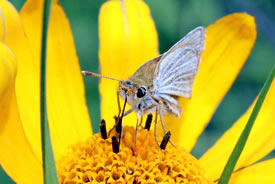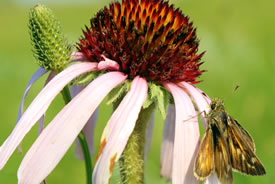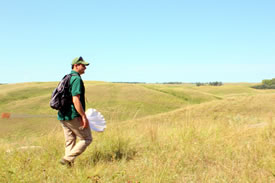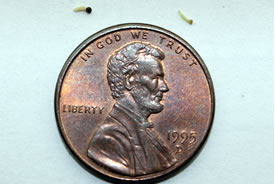Even rarer than a panda: How the Minnesota Zoo and NCC are collaborating to save one of the world's most endangered butterflies

Poweshiek skipperling, MB (Photo by Erik Runquist, Minnesota Zoo)
Listed as an endangered species in Manitoba in 2012 and nationally as threatened, the Poweshiek skipperling has decreased dramatically throughout North America. In Canada, It is known to only inhabit 17 fields in southeastern Manitoba, primarily on the Nature Conservancy of Canada’s (NCC’s) Tall Grass Prairie Natural Area. In the United States, the closest population appears only in a handful of sites in Wisconsin and Michigan.
This summer, researchers travelled to Winnipeg to perform research on this declining species. Among them was a researcher from the Minnesota Zoo, who was there to gather eggs from Poweshiek skipperlings as part of a captive breeding program.
Erik Runquist is a butterfly conservation biologist at the Minnesota Zoo and heads the Poweshiek skipperling recovery program as part of the Zoo’s Prairie Butterfly Conservation Program. Christine Beevis Trickett, managing editor of Land Lines, recently spoke with Erik about the project and the zoo’s efforts to protect endangered species around the world.
CBT: Can you tell me a bit about the butterfly conservation program at the Minnesota Zoo and how it began?
ER: The Prairie Butterfly Conservation Program started in February 2012 in recognition of the increasing collapse of butterflies across the upper Midwest. In Minnesota, 15 butterflies are at risk, and two thirds are prairie butterflies. Among those, the Poweshiek skipperling and Dakota skipper are at the top of the endangered species list and were proposed for listing at the national level as endangered and threatened this October.

Female Dakota skipper (Photo by Erik Runquist, Minnesota Zoo)
The program is Minnesota-centric but it’s an international effort. For instance, we are working in partnership with NCC to study the Poweshiek skipperling. Although it’s extinct in Minnesota, there are still populations in Manitoba (in addition to Michigan and Wisconsin).
CBT: What is the program trying to accomplish?
ER: Our primary goal is to use the zoo’s experience for the managed breeding of endangered species and to apply these lessons to the butterfly. We hope to establish breeding populations of the Poweshiek skipperlings and Dakota skippers at the zoo as insurance against the risk of extinction.
A second goal is to facilitate and perform field surveys in wild — many sites where these species are found have not been well surveyed, and we know little about them.
We’re also working on conservation and genetics studies to understand the level of diversity within and across populations and their divergence. Before our work, no data existed on the genetic divergence of Poweshiek skipperlings and Dakota skipper.
The Poweshiek is a species that was once common, and now it’s extinct across 90 percent of its range. We’re trying to understand this collapse and why it happened. One of our future areas of study may be on the impact of agricultural pesticides, which is important because the skipperling’s range is focused predominantly in agricultural lands.
Finally, we want to use our potential as an outreach and educational organization to talk about these butterflies and their habitat, as well as the ways in which people can help them.
CBT: Is this focus on conservation a recent one?
ER: The Minnesota Zoo has always first and foremost thought of itself as a conservation and education organization — we see that as our major role. But under this new grant we’ve shifted our focus to more local species.
Our goal is not just to display animals on exhibit. That’s an antiquated view we still struggle to change. We’re not in the business to put animals in cages. We’re here to secure a future for species.
We’re currently working on more than 60 species survival plans for endangered species and are part of cooperative programs between zoos around the world to promote the sustainable and genetic integrity of species.
CBT: What makes zoos uniquely qualified to do this work, rather than a conservation group or a wildlife rehabillitation centre?
ER: Zoos have the capacity to create viable and large breeding populations. This requires elaborate facilities that are beyond the ability of most organizations. There’s also a network of zoos to cooperate on programs.

Erik Runquist, butterfly surveys at Glacial Lakes State Park (Photo by Erik Runquist, Minnesota Zoo)
CBT: Can you describe the work you are doing with the Poweshiek skipperling?
ER: This year, we visited the tall grass prairie in Manitoba during the adult flight period, which lasts two weeks (if that). We collected females with the condition that the individuals collected do not equal more than 20 percent of the population observed.
Then, we brought them to a secure environment (usually a hotel room), where we put each individual in a paper or plastic cup with a screen and sugar water. We let them lay their eggs (usually this takes about two days), then released the females back into the wild.
We then brought the eggs to the zoo to rear them as caterpillars. We believe that more individuals survive to adulthood in our care than in the wild because we can eliminate predators, minimize disease and control for extreme weather.
We’re learning a lot and figuring it out as we go. Many eggs have even managed to make it to adulthood. But we still need to figure out the overwintering process and no actual breeding has happened yet at the zoo.
It’s challenging at times and frustrating. But I’m optimistic we can get there.
CBT: What are some of the challenges this species faces?

Upper left: Dakota skipper, upper right: Poweshiek skipperling (Photo by Erik Runquist, Minnesota Zoo)
ER: Last season, the numbers were way down in Wisconsin, Minnesota and Manitoba. This kicked this endangered species when it was already down.
This year across its range, fewer than 150 Poweshieks were seen in the wild, which is a third or less than the previous year. We’re probably still talking fewer than 500 individuals in the world.
That makes the Poweshiek species three times rarer than a panda, and among the most endangered animals on Earth. But very few people know about it, although it was once one of the most common species in the prairies.
CBT: How has this impacted your research?
ER: These numbers made it very hard to get anything this year. We canceled our Michigan and Wisconsin trips and sent one researcher to Manitoba.
We only found and got eggs from one female, which laid 11 eggs. Of those eggs, seven hatched. Three made it all the way and went into pupation, but there was no mating since all three were female. So now we have no Poweshieks in the lab at the moment but we do have Dakota skippers, which are a meatier, more robust species. We hope to get them breeding next year.
CBT: What are you hoping to accomplish, by getting these species breeding?
ER: The goal is not to release them just yet, but just to demonstrate that we can sustain populations of these species over several years. Until we have a degree of confidence that the threats that caused the decrease are gone, we wouldn’t be able to consider releasing them back into the wild.
Our goal is to secure these species’ future genetically. But it’s a challenge: while larger species such as rhinoceros have many reproductive years and many opportunities to breed, Poweshieks have only two weeks per year to replace the entire species, so they’re even more troubled.
We also want to get out the word that this is not a single species problem. So many butterflies have collapsed in the environment — this tells us something is wrong in the prairies that we need to investigate further.
CBT: Thank you, Erik!


